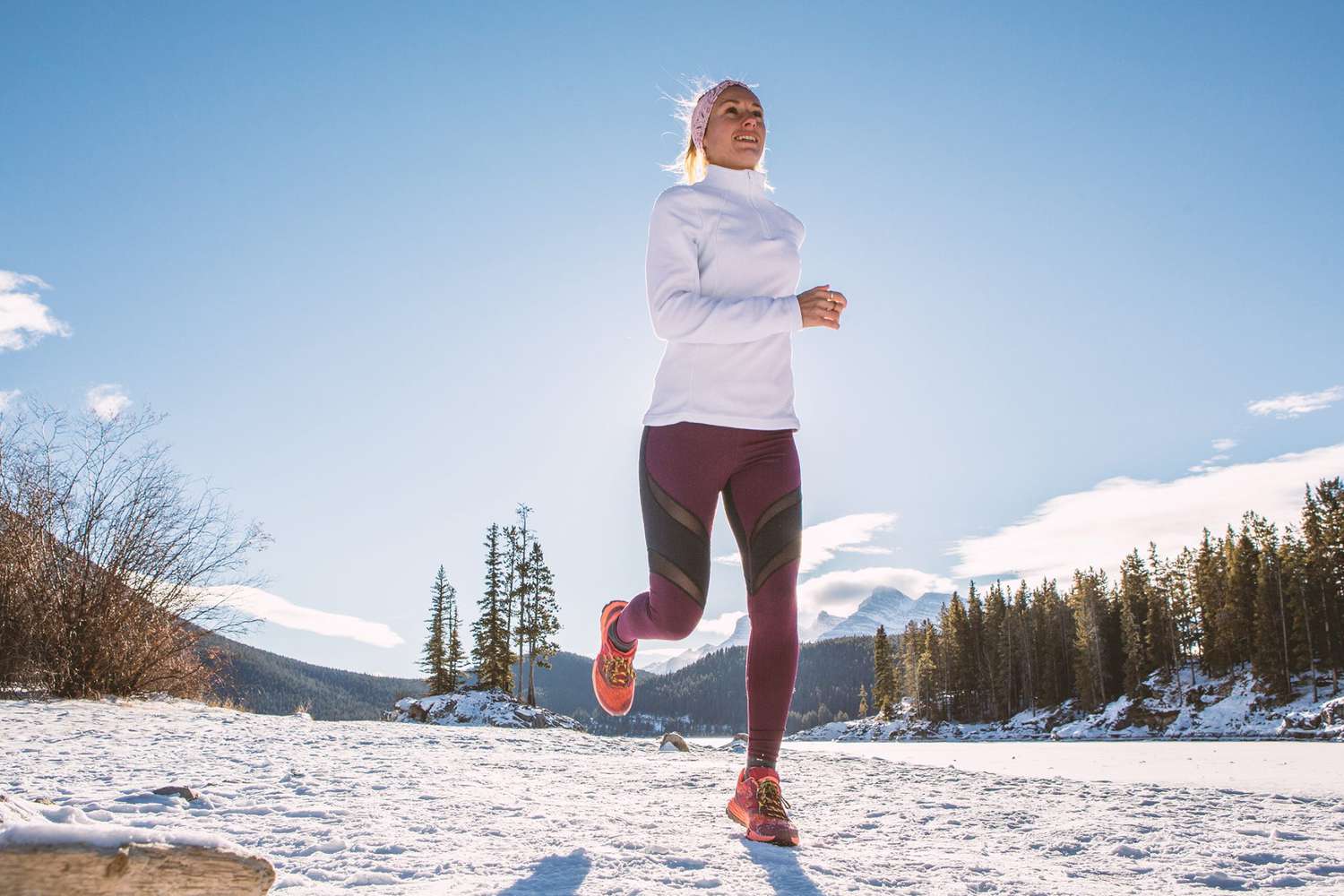As the days get shorter and the temperature drops, runners around the world prepare for the winter running season. While it may be tempting to stay inside by a warm fire, there are many reasons why runners should keep braving the cold weather. In this blog post, we’ll discuss all you need to know about running in the cold, including how to dress appropriately, stay safe, and make the most of your winter runs. So lace up your sneakers and let’s get started!
Winter running benefits
Let’s start on a positive note and explore some reasons why running in winter can be beneficial for you.
Burn more calories
Running in cold weather makes you work harder as your body tries to stay warm, which means you end up burning more calories than if you run in a warm environment. But burning more calories does not necessarily mean burning more fat. Cold weather running may also increase your appetite.
Enhanced immune system
When you subject your body to cold temperatures, it helps build up immunity against illnesses and diseases in the long run. When you first start running in cold weather (the same applies to taking cold showers), you may get sick more easily; however, with time, your immune system will gradually improve.
Greater mental toughness
Pushing yourself through a run during inclement weather is a great way to increase your mental toughness and build resilience which you will definitely need in order to reach your running goals. It will not be easy sometime, but if it would be, anyone would do it.

Improved endurance
The cold weather tends to make us more resistant to physical effort, and running during this time can help improve your endurance level and performance over time.
It feels great
Running in cold weather can be incredibly refreshing and rejuvenating. The rush of air against your skin will make you feel energized and simply… alive! You will feel happier with yourself and your confidence will grow.
The dangers of running in cold weather
As usual, there are two sides to everything. Despite the potential benefits of running in cold weather, there are some risks that you should be aware of when venturing outside in cold temperatures.
Health risks
Running in winter weather is not for everyone. Especially not for running novices with pre-existing health conditions such as asthma, diabetes, or hypertension.
Cold air can cause constriction of the blood vessels and result in tightness of the chest and breathing difficulties. This leads to a decrease in oxygen intake and an increase in fatigue which can put runners at risk of developing a more serious health condition from overexertion.
It is important for people with existing health conditions to take extra precautions when running in cold weather and consult their doctor before doing so.
Motivation
In addition to health risks, running in cold weather may also present mental challenges at a certain point. The colder temperatures can make it more difficult to stay motivated and focused on the task at hand. This may lead to feelings of apathy and disinterest in running, as well as a decrease in motivation to continue. For this reason, it is important for runners to take the time to plan out their runs and set achievable goals in order to stay motivated and focused on achieving their fitness objectives.
How to dress for a winter run
Understanding the importance of having the right gear and dressing properly for winter running is the most important aspect and core takeaway for runners reading this article. Not only it will make running outdoors safer but also more enjoyable.

How warm should you dress?
Dressing for a winter outdoor running may be a little bit tricky. It might be freezing outside, but that doesn’t mean you have to dress like an Eskimo. When you start to exercise, you will begin to produce a lot of body heat and you will sweat. The last thing you want is to feel too hot and undressing during the run.
So how to avoid overdressing? There is a simple hint for that. Always dress as if the outside temperature would be 20 °F (10 °C) higher than it actually is. You might feel a bit chilly before you start to work out, but that will change very quickly as your muscles warm up.
Layering
Layering is key when dressing for a winter run. Let’s see how it works.
Start with a breathable base layer such as long-sleeve shirts or thermal wear. This will keep your core warm while allowing sweat to escape and evaporate quickly so you stay dry and comfortable.
Over this layer, add an insulated mid-layer such as a softshell vest or jacket. It should create an air barrier to trap body heat and keep you warm. Pick something that won’t feel bulky or restrict your movements.
Lastly, top off your look with outer shell rainwear or windbreaker that’s windproof and water resistant – perfect for warding off chilly winds and occasional flurries of snow!

Fabrics
In general, look out for technical fabrics that are designed to wick moisture away from the body and keep you warm. This includes fabrics like polyester, nylon, and spandex.
These materials are lightweight yet sturdy enough to combat cold weather conditions while still keeping your body temperature regulated. Avoid wearing cotton as it tends to trap sweat close to the body and make you feel chilly in wet or cold conditions.
Accessories
Don’t forget to add the finishing touches to keep your extremities warm. The right gear makes a huge difference during colder months.
Gloves and a hat are essential, as these areas tend to lose heat quickly. Opt for something lightweight with windproof and water-resistant materials that won’t restrict movement or impair your vision when running.
When I go for winter jogging, a snug-fitting neck gaiter is my personal must. It is great for protecting the neck and face from wind chill and it helps me to retain more body heat which feels great.

Socks are also important, as your feet will be under a lot of strain during outdoor winter activities. Look for moisture-wicking material with good insulation and cushioning, such as wool or synthetic blends.
Running shoes
Your winter running shoes are an essential part of your gear, and they should be able to handle colder weather, ice and snow. Always make sure they are fitted properly with fresh insoles and laces tight enough so they don’t slip off during the run.
If you want to run in the snow or slush, it’s a good idea to wear shoes that are waterproof. Keeping your feet dry during winter running is essential for staying comfortable and avoiding blisters.
Regarding outsoles, choose ones that can handle slippery ice terrain. These will be probably more robust ones to give you more stability and support. There are many brands on the market that offer trail running shoes that are ideal for winter running.
Tips for staying warm during cold weather run
Since it has already been a couple of winter seasons that I have been running and preparing for a spring running event, let me give you a couple of tips to make running in cooler temperatures easier for you. Better than learning it the hard way!
Protect your head and neck
The single most important piece of advice and the main difference between running in cold weather and warm weather. Even though it may seem obvious, I often see many runners not covering their heads and neck.
Make sure to cover up these areas as they are most prone to losing heat, especially when wet. Wear a windproof running hat and a neck gaiter or scarf, to keep warm during cold run.

Use gloves
When you go on extensive runs, a lot of blood gets redirected to your running muscles. Your extremities, such as your fingers, have less blood flowing through them and are thus more vulnerable to cold air.
That is why gloves are essential for keeping your hands warm and comfortable during cold weather running. Make sure to get some lightweight, breathable gloves that will keep your hands warm without compromising dexterity.
Hand warmers
You may additionally use hand warmers. If you find your fingers are still cold despite wearing quality gloves, try using hand warmers that fit into your gloves to help keep them warm.
Keep moving
To keep your body temperature while running in cold weather, make sure to keep an active pace instead of slowing down too much when the temperatures drop. This will also help you avoid getting chilled if there’s a gust of cold wind during your run.
Hydrate and fuel regularly
Even if you may often not feel like it, you’ll need to hydrate and fuel up in the same way as you would during warmer conditions. Drinking water and eating small snacks such as energy gels or bars can help keep your body temperature up.

Don’t forget sunscreen
Even though it’s cold outside, make sure not to forget the sunscreen, especially for longer runs. The sun’s intense rays are still able to penetrate clouds.
Safety precautions to take when going on a winter run
Enjoy your winter jogging but stay safe at the same time. Let’s take a look at some basic safety tips to keep in mind when running during the colder months.
Be cautious about the route
If you’re running outdoors during the daytime, try to steer clear of routes with lots of ice or snow. At night or low-light conditions, choose well-lit, populated routes. Run with a buddy if possible, stay aware of your surroundings, avoid isolated areas, carry identification (ID) with you at all times, and be mindful of potential dangers such as ice patches, snowbanks, and slippery surfaces.

Use reflective gear
It gets darker earlier in the winter months so make sure to wear bright-colored clothes and reflective gear such as vests to make sure you’re visible. This is especially true when running on the side of the roads.






